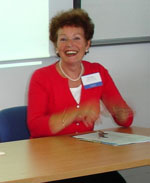Freelance Lecturer
Starting off
Teaching Full-time
It was after delivering freelance lectures for Sotheby's Education that I was invited to work for them full-time as a Tutor in 1984. I began by teaching on the Foundation Course (Antiquity to the Present Day) which required intensive preparation for the assigned lectures and study visits to galleries and museums including the V&A. I had to become familiar with the decorative as well as the fine art of each period and pre-viewing sales at the auction house meant that I needed to understand the commercial aspects too. Having spent that term in Venice I felt well equipped to take my students there and to Florence and Rome.
During my time at Sotheby's the courses evolved from being vocational courses to validated (University of Manchester) undergraduate and post-graduate courses and the department changed its name to Sotheby's Institute. Validation increased the work load considerably as the academic requirements of the syllabus, examinations and continuous student assessment were now central to the courses.
As part of these academic changes I was encouraged to develop my ideas for a validated course which I felt fitted with the Auction House history. Entitled Academies and the Avant-Garde the course considered the history of changing taste and the collecting of paintings in Nineteenth Century Europe. I now took my students to Paris and became familiar with the major galleries and museums there.
In Retirement
I retired from Sotheby's Institute in 2002 and then taught at Christie's for one year. I could have continued teaching but I felt it was time to live at a less demanding pace. I now lecture occasionally for various organisations and am pleased that I am no longer involved with the planning and day to day running of courses and the marking of student essays and examination papers.
Freelance Lecturing - Advantages and Disadvantages
Freelance lecturing allows you to earn while you learn. It does not pay well but gives flexibility when balancing work, family and other commitments. For someone studying for a Masters degree or PhD it could provide a small income and might lead to full-time employment.
Lecturing for a wide range of organisations is a very good way of building up a network of contacts within the art world. Often another freelance lecturer will recommend you when a need arises. Other invitations come about because someone hears you and thinks you would be right for their group. You get to hear of up-coming full-time posts and it is an advantage if you have already done some work for prospective employers.
There may also be opportunities to travel. I have organised study visits to Europe and Scandinavia and even lectured twice on the QEII to groups of retired Americans. Such trips allow one to get to know different cities and their museums.
Is Lecturing for You?
Do you like researching material for your seminar presentations?
Do you enjoy giving presentations?
Could you keep the attention of your group in a public gallery?
Would you enjoy the responsibility of taking a group abroad?
How and Where to begin
Contact your local Museum or Art Gallery to see if they have an Education Department. Listen to some of the guided lectures, note how they are presented and consider how you would have given the talk. Offer them a short list of lectures you could give based on their collection.
Use your local library to find out what groups meet in your area and send them your cv and lecture titles. University of the Third Age, Women's Institute, Probus, WEA, Extra-Mural classes run by Universities, Colleges of Education and Art Colleges can all provide useful opportunities to develop one's range and skills.
What I would do NOW
If I were starting off today I would:
- Get a PhD as most employers are looking for this qualification
- Become fluent in a European language
- Have a specialist subject - artist, school, designer (of glass, ceramics, furniture) sculptor, architect
- Aim to publish on that subject and get involved in forthcoming exhibitions or catalogues
- Use Power Point not slides
Our expert:
Sue Jenkins

